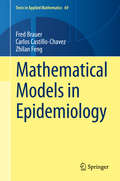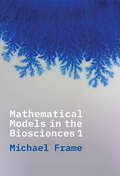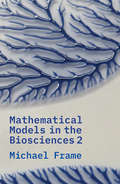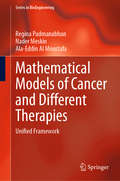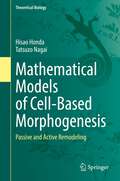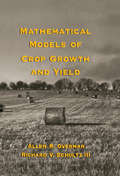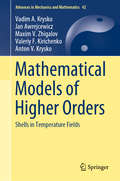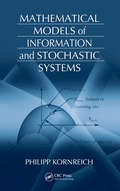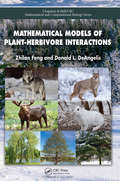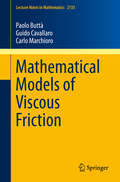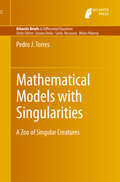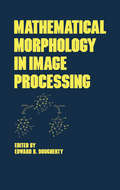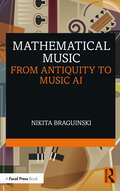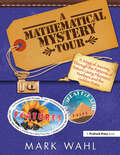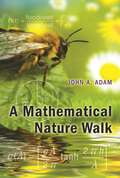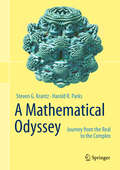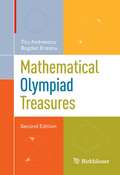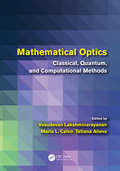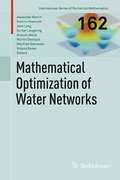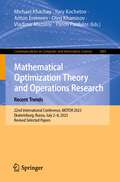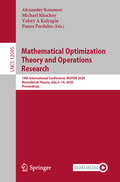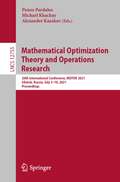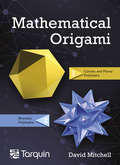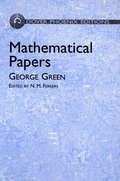- Table View
- List View
Mathematical Models in Epidemiology (Texts in Applied Mathematics #69)
by Carlos Castillo-Chavez Fred Brauer Zhilan FengThe book is a comprehensive, self-contained introduction to the mathematical modeling and analysis of disease transmission models. It includes (i) an introduction to the main concepts of compartmental models including models with heterogeneous mixing of individuals and models for vector-transmitted diseases, (ii) a detailed analysis of models for important specific diseases, including tuberculosis, HIV/AIDS, influenza, Ebola virus disease, malaria, dengue fever and the Zika virus, (iii) an introduction to more advanced mathematical topics, including age structure, spatial structure, and mobility, and (iv) some challenges and opportunities for the future.There are exercises of varying degrees of difficulty, and projects leading to new research directions. For the benefit of public health professionals whose contact with mathematics may not be recent, there is an appendix covering the necessary mathematical background. There are indications which sections require a strong mathematical background so that the book can be useful for both mathematical modelers and public health professionals.
Mathematical Models in the Biosciences I
by Michael FrameAn award-winning professor’s introduction to essential concepts of calculus and mathematical modeling for students in the biosciences This is the first of a two-part series exploring essential concepts of calculus in the context of biological systems. Michael Frame covers essential ideas and theories of basic calculus and probability while providing examples of how they apply to subjects like chemotherapy and tumor growth, chemical diffusion, allometric scaling, predator-prey relations, and nerve impulses. Based on the author’s calculus class at Yale University, the book makes concepts of calculus more relatable for science majors and premedical students.
Mathematical Models in the Biosciences II
by Michael FrameVolume Two of an award-winning professor&’s introduction to essential concepts of calculus and mathematical modeling for students in the biosciences This is the second of a two-part series exploring essential concepts of calculus in the context of biological systems. Building on the essential ideas and theories of basic calculus taught in Mathematical Models in the Biosciences I, this book focuses on epidemiological models, mathematical foundations of virus and antiviral dynamics, ion channel models and cardiac arrhythmias, vector calculus and applications, and evolutionary models of disease. It also develops differential equations and stochastic models of many biomedical processes, as well as virus dynamics, the Clancy-Rudy model to determine the genetic basis of cardiac arrhythmias, and a sketch of some systems biology. Based on the author&’s calculus class at Yale, the book makes concepts of calculus less abstract and more relatable for science majors and premedical students.
Mathematical Models of Cancer and Different Therapies: Unified Framework (Series in BioEngineering)
by Regina Padmanabhan Nader Meskin Ala-Eddin Al MoustafaThis book provides a unified framework for various currently available mathematical models that are used to analyze progression and regression in cancer development, and to predict its dynamics with respect to therapeutic interventions. Accurate and reliable model representations of cancer dynamics are milestones in the field of cancer research. Mathematical modeling approaches are becoming increasingly common in cancer research, as these quantitative approaches can help to validate hypotheses concerning cancer dynamics and thus elucidate the complexly interlaced mechanisms involved. Even though the related conceptual and technical information is growing at an exponential rate, the application of said information and realization of useful healthcare devices are lagging behind.In order to remedy this discrepancy, more interdisciplinary research works and course curricula need to be introduced in academic, industrial, and clinical organizations alike. To that end, this book reformulates most of the existing mathematical models as special cases of a general model, allowing readers to easily get an overall idea of cancer dynamics and its modeling. Moreover, the book will help bridge the gap between biologists and engineers, as it brings together cancer dynamics, the main steps involved in mathematical modeling, and control strategies developed for cancer management. This also allows readers in both medical and engineering fields to compare and contrast all the therapy-based models developed to date using a single source, and to identify unexplored research directions.
Mathematical Models of Cell-Based Morphogenesis: Passive and Active Remodeling (Theoretical Biology)
by Hisao Honda Tatsuzo NagaiThis book describes the shape formation of living organisms using mathematical models. Genes are deeply related to the shape of living organisms, and elucidation of a pathway of shape formation from genes is one of the fundamental problems in biology. Mathematical cell models are indispensable tools to elucidate this problem. The book introduces two mathematical cell models, the cell center model and the vertex model, with their applications. The cell center model is applied to elucidate the formation of neat cell arrangements in epidermis, cell patterns consisting of heterogeneous-sized cells, capillary networks, and the branching patterns of blood vessels. The vertex model is applied to elucidate the wound healing mechanisms of the epithelium and ordered pattern formation involving apoptosis. Pattern formation with differential cell adhesion is also described. The vertex model is then extended from a two-dimensional (2D) to a three-dimensional (3D) model. A cell aggregate involving a large cavity is described to explain the development of the mammalian blastocyst or the formation of an epithelial vesicle. Epithelial tissues and the polarity formation process of the epithelium are also explained. The vertex model also recapitulates active remodeling of tissues and describes the twisting of tissue that contributes to understanding the cardiac loop formation of the embryonic tube. The book showcases that mathematical cell models are indispensable tools to understand the shape formation of living organisms. Successful contribution of the mathematical cell models means that the remodeling of collective cells is self-construction. Examining the successive iterations of self-constructions leads to understanding the remarkable and mysterious morphogenesis that occurs during the development of living organisms. The intended readers of this book are not only theoretical or mathematical biologists, but also experimental and general biologists, including undergraduate and postgraduate students who are interested in the relationship between genes and morphogenesis.
Mathematical Models of Crop Growth and Yield (Books In Soils, Plants, And The Environment Ser. #Vol. 91)
by Allen R. Overman Richard V. Scholtz IIIHighlighting effective, analytical functions that have been found useful for the comparison of alternative management techniques to maximize water and nutrient resources, this reference describes the application of viable mathematical models in data analysis to increase crop growth and yields. Featuring solutions to various differential equations,
Mathematical Models of Higher Orders: Shells In Temperature Fields (Advances in Mechanics and Mathematics #42)
by Jan Awrejcewicz Vadim A. Krysko Maxim V. Zhigalov Valeriy F. Kirichenko Anton V. KryskoThis book offers a valuable methodological approach to the state-of-the-art of the classical plate/shell mathematical models, exemplifying the vast range of mathematical models of nonlinear dynamics and statics of continuous mechanical structural members. The main objective highlights the need for further study of the classical problem of shell dynamics consisting of mathematical modeling, derivation of nonlinear PDEs, and of finding their solutions based on the development of new and effective numerical techniques. The book is designed for a broad readership of graduate students in mechanical and civil engineering, applied mathematics, and physics, as well as to researchers and professionals interested in a rigorous and comprehensive study of modeling non-linear phenomena governed by PDEs.
Mathematical Models of Information and Stochastic Systems
by Philipp KornreichFrom ancient soothsayers and astrologists to today’s pollsters and economists, probability theory has long been used to predict the future on the basis of past and present knowledge. Mathematical Models of Information and Stochastic Systems shows that the amount of knowledge about a system plays an important role in the mathematical models used to foretell the future of the system. It explains how this known quantity of information is used to derive a system’s probabilistic properties. After an introduction, the book presents several basic principles that are employed in the remainder of the text to develop useful examples of probability theory. It examines both discrete and continuous distribution functions and random variables, followed by a chapter on the average values, correlations, and covariances of functions of variables as well as the probabilistic mathematical model of quantum mechanics. The author then explores the concepts of randomness and entropy and derives various discrete probabilities and continuous probability density functions from what is known about a particular stochastic system. The final chapters discuss information of discrete and continuous systems, time-dependent stochastic processes, data analysis, and chaotic systems and fractals. By building a range of probability distributions based on prior knowledge of the problem, this classroom-tested text illustrates how to predict the behavior of diverse systems. A solutions manual is available for qualifying instructors.
Mathematical Models of Plant-Herbivore Interactions (Chapman & Hall/CRC Mathematical Biology Series)
by Zhilan Feng Donald DeAngelisMathematical Models of Plant-Herbivore Interactions addresses mathematical models in the study of practical questions in ecology, particularly factors that affect herbivory, including plant defense, herbivore natural enemies, and adaptive herbivory, as well as the effects of these on plant community dynamics. <P><P> The result of extensive research on the use of mathematical modeling to investigate the effects of plant defenses on plant-herbivore dynamics, this book describes a toxin-determined functional response model (TDFRM) that helps explains field observations of these interactions. <P><P> This book is intended for graduate students and researchers interested in mathematical biology and ecology.
Mathematical Models of Viscous Friction
by Paolo Buttà Guido Cavallaro Carlo MarchioroIn this monograph we present a review of a number of recent results on the motion of a classical body immersed in an infinitely extended medium and subjected to the action of an external force. We investigate this topic in the framework of mathematical physics by focusing mainly on the class of purely Hamiltonian systems, for which very few results are available. We discuss two cases: when the medium is a gas and when it is a fluid. In the first case, the aim is to obtain microscopic models of viscous friction. In the second, we seek to underline some non-trivial features of the motion. Far from giving a general survey on the subject, which is very rich and complex from both a phenomenological and theoretical point of view, we focus on some fairly simple models that can be studied rigorously, thus providing a first step towards a mathematical description of viscous friction. In some cases, we restrict ourselves to studying the problem at a heuristic level, or we present the main ideas, discussing only some aspects of the proof if it is prohibitively technical. This book is principally addressed to researchers or PhD students who are interested in this or related fields of mathematical physics.
Mathematical Models with Applications
by Ralph Bertelle Judith Bloch Roy CameronNIMAC-sourced textbook
Mathematical Models with Singularities
by Pedro J. TorresThe book aims to provide an unifying view of a variety (a 'zoo') of mathematical models with some kind of singular nonlinearity, in the sense that it becomes infinite when the state variable approaches a certain point. Up to 11 different concrete models are analyzed in separate chapters. Each chapter starts with a discussion of the basic model and its physical significance. Then the main results and typical proofs are outlined, followed by open problems. Each chapter is closed by a suitable list of references. The book may serve as a guide for researchers interested in the modelling of real world processes.
Mathematical Morphology in Image Processing (Optical Science and Engineering #1)
by Edward DoughertyPresents the statistical analysis of morphological filters and their automatic optical design, the development of morphological features for image signatures, and the design of efficient morphological algorithms. Extends the morphological paradigm to include other branches of science and mathematics.;This book is designed to be of interest to optical, electrical and electronics, and electro-optic engineers, including image processing, signal processing, machine vision, and computer vision engineers, applied mathematicians, image analysts and scientists and graduate-level students in image processing and mathematical morphology courses.
Mathematical Music: From Antiquity to Music AI
by Nikita BraguinskiMathematical Music offers a concise and easily accessible history of how mathematics was used to create music. The story presented in this short, engaging volume ranges from ratios in antiquity to random combinations in the 17th century, 20th-century statistics, and contemporary artificial intelligence. This book provides a fascinating panorama of the gradual mechanization of thought processes involved in the creation of music. How did Baroque authors envision a composition system based on combinatorics? What was it like to create musical algorithms at the beginning of the 20th century, before the computer became a reality? And how does this all explain today’s use of artificial intelligence and machine learning in music? In addition to discussing the history and the present state of mathematical music, Braguinski also takes a look at what possibilities the near future of music AI might hold for listeners, musicians, and the society. Grounded in research findings from musicology and the history of technology, and written for the non-specialist general audience, this book helps both student and professional readers to make sense of today’s music AI by situating it in a continuous historical context.
A Mathematical Mystery Tour: Higher-Thinking Math Tasks (Grades 5-12)
by Mark WahlA Mathematical Mystery Tour has been used by thousands of students and has inspired adults to greater appreciation of the secret number language of nature. It is multidisciplinary, visual, and hands-on, practicing skills while also requiring deep math thinking. The activities are reproducible and each is accompanied with informational teacher pages giving answers, historical notes, teacher suggestions, and activity extensions.Let this geographically alive Mystery Tour integrate math with art, science, philosophy, history, social studies, and language arts. The use of the calculator, geometric construction, metric measurement, problem solving, formulating results, building models and making inferences is woven throughout the book.Each book purchase includes a link to a downloadable student newspaper, the Mathematical Mystery Tour Guide, coordinated with the book content. It is capable of being broken up into various assignments and handed out as print or sent whole electronically to each student. It is filled with games, riddles, dramatic historical information, crosswords, provocative questions, and additional math thought activities.
A Mathematical Nature Walk
by John AdamHow heavy is that cloud? Why can you see farther in rain than in fog? Why are the droplets on that spider web spaced apart so evenly? If you have ever asked questions like these while outdoors, and wondered how you might figure out the answers, this is a book for you. An entertaining and informative collection of fascinating puzzles from the natural world around us, A Mathematical Nature Walk will delight anyone who loves nature or math or both. John Adam presents ninety-six questions about many common natural phenomena--and a few uncommon ones--and then shows how to answer them using mostly basic mathematics. Can you weigh a pumpkin just by carefully looking at it? Why can you see farther in rain than in fog? What causes the variations in the colors of butterfly wings, bird feathers, and oil slicks? And why are large haystacks prone to spontaneous combustion? These are just a few of the questions you'll find inside. Many of the problems are illustrated with photos and drawings, and the book also has answers, a glossary of terms, and a list of some of the patterns found in nature. About a quarter of the questions can be answered with arithmetic, and many of the rest require only precalculus. But regardless of math background, readers will learn from the informal descriptions of the problems and gain a new appreciation of the beauty of nature and the mathematics that lies behind it.
A Mathematical Odyssey: Journey from the Real to the Complex
by Harold R. Parks Steven G. KrantzMathematics is a poem. It is a lucid, sensual, precise exposition of beautiful ideas directed to specific goals. It is worthwhile to have as broad a cross-section of mankind as possible be conversant with what goes on in mathematics. Just as everyone knows that the Internet is a powerful and important tool for communication, so everyone should know that the Poincaré conjecture gives us important information about the shape of our universe. Just as every responsible citizen realizes that the mass-production automobile was pioneered by Henry Ford, so everyone should know that the P/NP problem has implications for security and data manipulation that will affect everyone. This book endeavors to tell the story of the modern impact of mathematics, of its trials and triumphs and insights, in language that can be appreciated by a broad audience. It endeavors to show what mathematics means for our lives, how it impacts all of us, and what new thoughts it should cause us to entertain. It introduces new vistas of mathematical ideas and shares the excitement of new ideas freshly minted. It discusses the significance and impact of these ideas, and gives them meaning that will travel well and cause people to reconsider their place in the universe. Mathematics is one of mankind's oldest disciplines. Along with philosophy, it has shaped the very modus of human thought. And it continues to do so. To be unaware of modern mathematics is to miss out on a large slice of life. It is to be left out of essential modern developments. We want to address this point, and do something about it. This is a book to make mathematics exciting for people of all interests and all walks of life. Mathematics is exhilarating, it is ennobling, it is uplifting, and it is fascinating. We want to show people this part of our world, and to get them to travel new paths.
Mathematical Olympiad Treasures
by Titu Andreescu Bogdan EnescuMathematical Olympiad Treasures aims at building a bridge between ordinary high school exercises and more sophisticated, intricate and abstract concepts in undergraduate mathematics. The book contains a stimulating collection of problems in the subjects of algebra, geometry, trigonometry, number theory and combinatorics. While it may be considered a sequel to "Mathematical Olympiad Challenges," the focus is on engaging a wider audience to apply techniques and strategies to real-world problems. Throughout the book students are encouraged to express their ideas, conjectures, and conclusions in writing. The goal is to help readers develop a host of new mathematical tools that will be useful beyond the classroom and in a number of disciplines.
Mathematical Optics: Classical, Quantum, and Computational Methods
by Vasudevan Lakshminarayanan Maria L. Calvo Tatiana AlievaGoing beyond standard introductory texts, Mathematical Optics: Classical, Quantum, and Computational Methods brings together many new mathematical techniques from optical science and engineering research. Profusely illustrated, the book makes the material accessible to students and newcomers to the field. Divided into six parts, the text presents state-of-the-art mathematical methods and applications in classical optics, quantum optics, and image processing. Part I describes the use of phase space concepts to characterize optical beams and the application of dynamic programming in optical waveguides. Part II explores solutions to paraxial, linear, and nonlinear wave equations. Part III discusses cutting-edge areas in transformation optics (such as invisibility cloaks) and computational plasmonics. Part IV uses Lorentz groups, dihedral group symmetry, Lie algebras, and Liouville space to analyze problems in polarization, ray optics, visual optics, and quantum optics. Part V examines the role of coherence functions in modern laser physics and explains how to apply quantum memory channel models in quantum computers. Part VI introduces super-resolution imaging and differential geometric methods in image processing. As numerical/symbolic computation is an important tool for solving numerous real-life problems in optical science, many chapters include Mathematica® code in their appendices. The software codes and notebooks as well as color versions of the book’s figures are available at www.crcpress.com.
Mathematical Optimization of Water Networks (International Series Of Numerical Mathematics Series #162)
by Alexander Martin Kathrin Klamroth Jens Lang Günter Leugering Antonio Morsi Martin Oberlack Manfred Ostrowski Roland RosenWater supply- and drainage systems and mixed water channel systems are networks whose high dynamic is determined and/or affected by consumer habits on drinking water on the one hand and by climate conditions, in particular rainfall, on the other hand. According to their size, water networks consist of hundreds or thousands of system elements. Moreover, different types of decisions (continuous and discrete) have to be taken in the water management. The networks have to be optimized in terms of topology and operation by targeting a variety of criteria. Criteria may for example be economic, social or ecological ones and may compete with each other. The development of complex model systems and their use for deriving optimal decisions in water management is taking place at a rapid pace. Simulation and optimization methods originating in Operations Research have been used for several decades; usually with very limited direct cooperation with applied mathematics. The research presented here aims at bridging this gap, thereby opening up space for synergies and innovation. It is directly applicable for relevant practical problems and has been carried out in cooperation with utility and dumping companies, infrastructure providers and planning offices. A close and direct connection to the practice of water management has been established by involving application-oriented know-how from the field of civil engineering. On the mathematical side all necessary disciplines were involved, including mixed-integer optimization, multi-objective and facility location optimization, numerics for cross-linked dynamic transportation systems and optimization as well as control of hybrid systems. Most of the presented research has been supported by the joint project „Discret-continuous optimization of dynamic water systems“ of the federal ministry of education and research (BMBF).
Mathematical Optimization Theory and Operations Research: 22nd International Conference, MOTOR 2023, Ekaterinburg, Russia, July 2–8, 2023, Revised Selected Papers (Communications in Computer and Information Science #1881)
by Michael Khachay Yury Kochetov Anton Eremeev Oleg Khamisov Vladimir Mazalov Panos PardalosThis book constitutes refereed proceedings of the 22nd International Conference on Mathematical Optimization Theory and Operations Research: Recent Trends, MOTOR 2023, held in Ekaterinburg, Russia, during July 2–8, 2023. The 28 full papers and one invited paper presented in this volume were carefully reviewed and selected from a total of 61 submissions. The papers in the volume are organized according to the following topical headings: mathematical programming; stochastic optimization; discrete and combinatorial optimization; operations research; optimal control and mathematical economics; and optimization in machine learning.
Mathematical Optimization Theory and Operations Research: 19th International Conference, MOTOR 2020, Novosibirsk, Russia, July 6–10, 2020, Proceedings (Lecture Notes in Computer Science #12095)
by Alexander Kononov Michael Khachay Valery A Kalyagin Panos PardalosThis book constitutes the proceedings of the 19th International Conference on Mathematical Optimization Theory and Operations Research, MOTOR 2020, held in Novosibirsk, Russia, in July 2020. The 31 full papers presented in this volume were carefully reviewed and selected from 102 submissions. The papers are grouped in these topical sections: discrete optimization; mathematical programming; game theory; scheduling problem; heuristics and metaheuristics; and operational research applications.
Mathematical Optimization Theory and Operations Research: 20th International Conference, MOTOR 2021, Irkutsk, Russia, July 5–10, 2021, Proceedings (Lecture Notes in Computer Science #12755)
by Panos Pardalos Michael Khachay Alexander KazakovThis book constitutes the proceedings of the 20th International Conference on Mathematical Optimization Theory and Operations Research, MOTOR 2021, held in Irkutsk, Russia, in July 2021. The 29 full papers and 1 short paper presented in this volume were carefully reviewed and selected from 102 submissions. Additionally, 2 full invited papers are presented in the volume. The papers are grouped in the following topical sections: combinatorial optimization; mathematical programming; bilevel optimization; scheduling problems; game theory and optimal control; operational research and mathematical economics; data analysis.
Mathematical Origami: Geometrical shapes by paper folding
by David MitchellThis book shows the reader how to make a range of robust polyhedra from ordinary printer paper using a technique known as modular origami. Modular origami designs are made by first folding several, or sometimes many, sheets of paper into simple individual modules and then by putting these modules together, normally without the help of any kind of adhesive, to create a finished polyhedral form. Modular origami design has moved on since the hugely popular first edition which has been expanded and revised to present both a wider range of designs, and to introduce new designs which are more robust and offer more potential for mathematical adventures. Ideal for the classroom and fun for any enthusiast of either origami, or mathematics. David Mitchell gives clear step-by-step instructions.
Mathematical Papers (Dover Books on Mathematics)
by George Green N. M. FerrersAn almost entirely self-taught mathematical genius, George Green (1793 -1841) is best known for Green's theorem, which is used in almost all computer codes that solve partial differential equations. He also published influential essays, or papers, in the fields of hydrodynamics, electricity, and magnetism. This collection comprises his most significant works.The first paper, "An Essay on the Application of Mathematical Analysis to the Theories of Electricity and Magnetism," which is also the longest and perhaps the most Important, appeared In 1828. It introduced the term potential as designating the result obtained by adding together the masses of all the particles of a system, each divided by its distance from a given point. Its three-part treatment first considers the properties of this function and then applies them, in the second and third parts, to the theories of magnetism and electricity.The following paper, "Mathematical Investigations concerning the Laws of the Equilibrium of Fluids analogous to the Electric Fluid," exhibits great analytical power, as does the next, "On the Determination of the Exterior and Interior Attractions of Ellipsoids of Variable Densities." Other highlights include the brief but absorbing paper, "On the Motion of Waves in a variable canal of small depth and width," and two of his most valuable memoirs, "On the Laws of Reflexlon and Refraction of Sound" and "On the Reflexlon and Refraction of Light at the common surface of two non-crystallized Media," which should be studied together.
